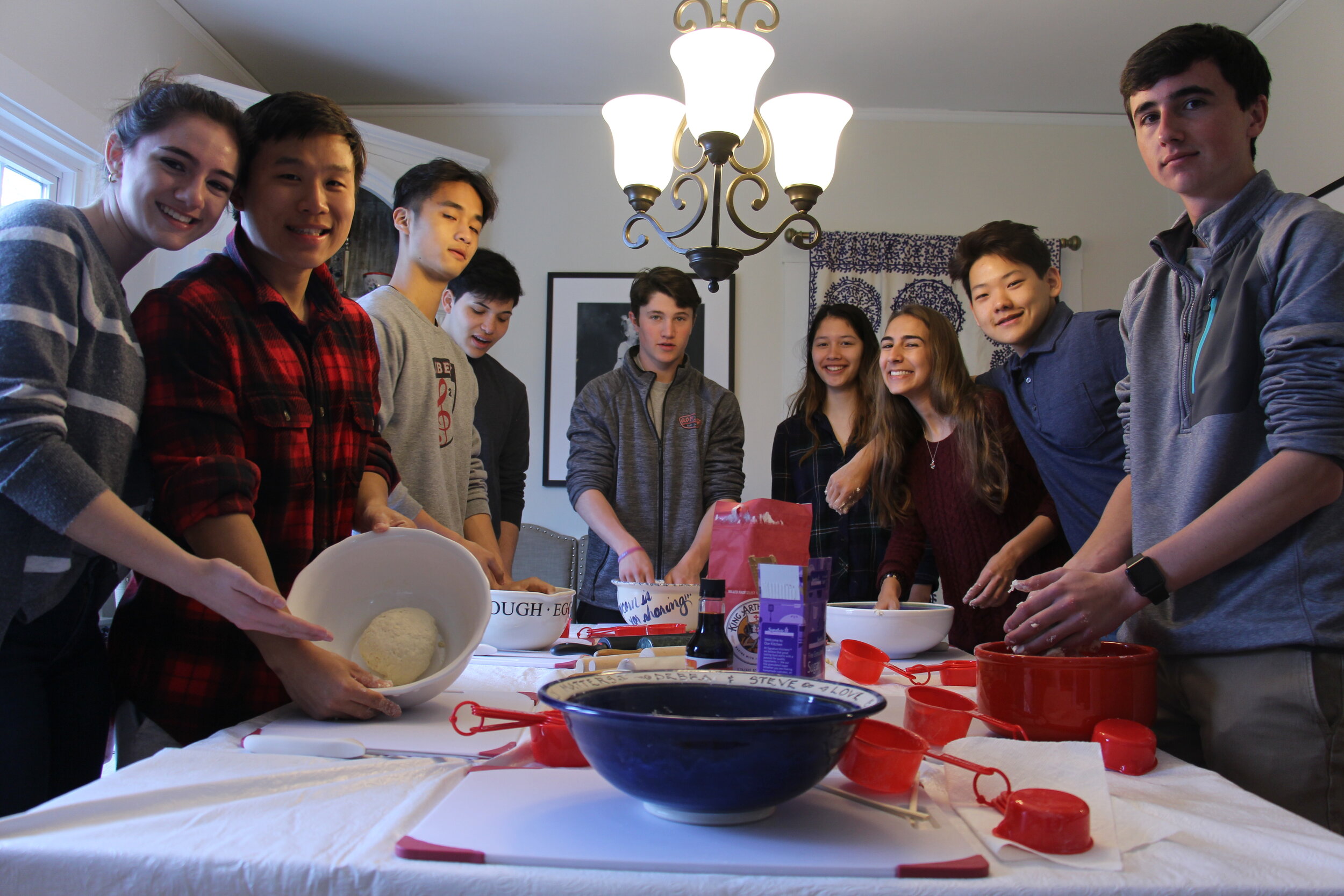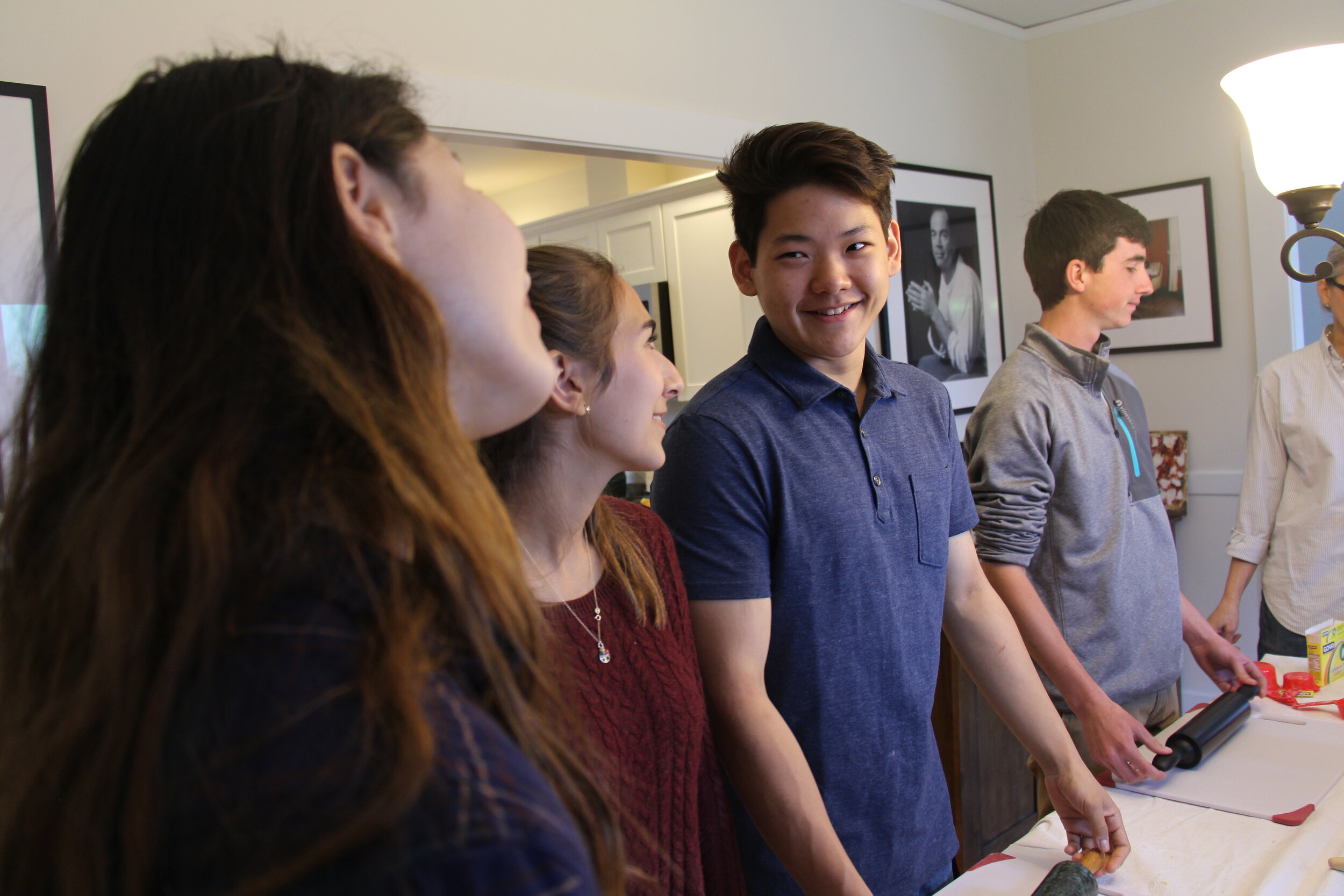Dumplings
This week, our Culinary Art’s club adventures into my own culinary culture of Chinese food. Thanks to the generosity and help of the Butler family and their exchange student, Stella, we were able to experience the full process of dumpling(饺子) and fried dough(麻花) making. Stella started off our dumpling session with the making of the flour dough. After seasoning the flour with salt and mixing it with egg and water, we gently kneaded the dough into a ball shape and repeated kneading until all the additional moisture of the dough was removed. After the fermentation of the dough, we shaped it into a long strand by slowly spreading our hands apart while rolling away from the center. We then divided it into individual chunks, patted them down and made them into a circular dumpling wrapper with a rolling pin. After preparing all the necessary material, Stella started her mind-blowing demonstration of dumpling making. Stella placed an appropriate amount of stuffing into the dumpling wrapper and sealed the wrapper with her magical hands, pinching and pulling at the same time, completing a fabulous looking dumpling. After a few disastrous attempts, I realized that the corporation of the two hands is absolutely crucial, the left hand pulling movement must match with the right hand pinching movement, which is extremely difficult. Stella placed her perfectly completed dumplings among my monstrous looking ones in a bamboo steamer and surprisingly sealed the steamer to the pan with a thin strand of excess dough in order to prevent the leaking of steam. The dumplings cooked perfectly. Despite some of their abnormal looks, the dumplings were packed with flavors and extremely juicy on the inside. After taking a bite, the delicious juice from the meat fillings flowed into my mouth, completely satisfying and warming my tastebuds. The meat fillings were extremely tender and had the perfect amount of saltiness accompanied by the dough. This delicacy that we created immediately brought me back to my native Chinese culture and made me feel like home. Using the excess dough and some food coloring, Stella then demonstrated us her way of making colorful and crunchy fried doughs. It was truly an amazing experience and it is exciting to know that I can make dumplings for myself anytime now!–Sam Ding ’18
For our first event of the Spring term, we did something a bit different than usual by gathering in the Butler’s home to make dumplings and fry dough. After learning that we would be paired up to do this, I was not overly-excited due to my previous-baking experience with a partner (sorry, Megan).
However, my attitude changed when I met Stella, a young exchange student who is living with the Butlers. She said how making dumplings and frying dough are two important traditions from China. The process of doing so was very concentrated as the dough required different ingredients, mixing techniques, and shapes before it was ready to be formed into a dumpling. I was surprised to hear from Stella that they do not measure while they are baking, instead, they taste while they cook to determine when the final product is ready. After the dumplings, we made the fried dough. My favorite part was using food color to dye our dough before frying it. My mix of yellow and red tasted just as good as it looked.
Overall, it was such a pleasure meeting Stella and learning about her culture through this dough and dumpling-making process.This was a very enjoyable and educational experience thanks to the Butlers and Stella. Thank you so much!–Michael Griffin ’18
As a Chinese, one of the most memorable family foods for me is dumpling. Dumplings could be the entree on the New Year, and the leftover could be the breakfast for the following morning. There are innumerable types of dumplings:from meatlover to gluten-free. Although dumplings are everywhere in China, this is my first time actually making dumplings myself. Unfortunately, the majority of my dumplings came out to be disfigured and few of those survived the steamer.
Another thing we made was the fried bread. At first I thought the name meant you tiao: A traditional Chinese breakfast item resembling an elongated fried dough. So when we started to massage the dough with food coloring, I had to clarify to Mrs. Bonin that this was not you tiao. Pieces of painted dough were fried until they are golden-brown and they tasted even better than what they looked like. —Peter Liu ’19
Last Sunday, on the 15th of April, the Portsmouth Abbey Culinary Club visited the Butler’s home in Bristol, RI. There we met Stella, a student who now attends Salve Regina University, but is originally from China. Stella showed us how to make traditional dumplings and Chinese fried dough. What I never realized until that day was how much of an art form cooking these two dishes really was.
My favorite part about cooking with Stella was learning the dumpling techniques which included making the dough, rolling and flattening the dough into small circles, and finally learning how to seal the dumplings so that the fillings would not fall out. After many attempts at trying to seal the dumplings, I had yet to perfect them the way Stella had done, but I definitely was on the right track! Thank you Stella and thank you to the Butlers for hosting us, we all had a great time. –Dan Sliney ‘18




















































































































